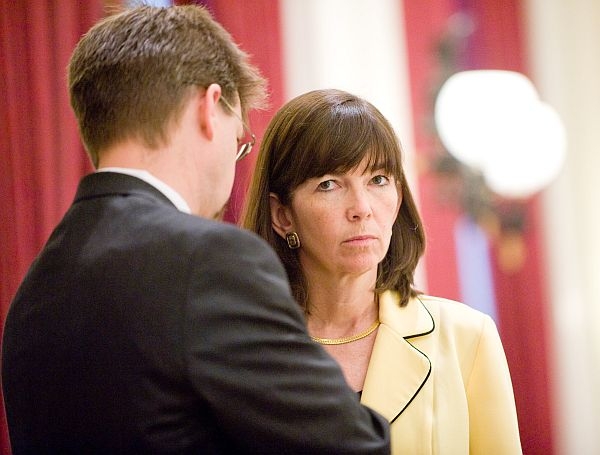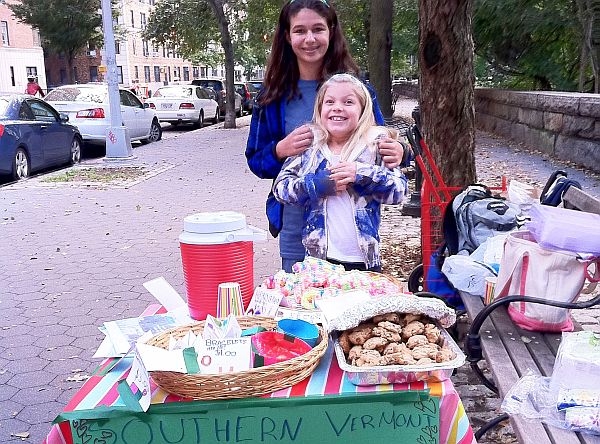Tropical Storm Irene turned many otherwise ordinary citizens into heroes.
Organizations also stepped up to the plate. Many became lifelines, both for people devastated by the damage and for those who wanted to help.
The nonprofit Stratton Foundation made a big difference in the lives of many southern Vermont residents. Jody Bonneville a single mother from South Londonderry, was among them.
Bonneville was sifting through the sodden wreckage of her son’s room when Patti Komline called and asked if she and Al Rogers could stop by.
Komline and Rogers had just been hired by the Stratton Foundation to manage flood relief in the hard-hit towns surrounding the resort.
Bonneville had suffered heavy damage.
"I was so distracted and so overwhelmed that I couldn’t think of an excuse," she says. "I’m usually good at that."
Bonneville had struggled for years to keep the home where she raised three sons. She’s worked nights, and taken n roommates to meet expenses.
Tropical storm Irene left her exhausted and short on hope.
She sighs, recalling that time: "Days of just trying to get the water out, get it dry, bleaching." She says the mold, which became a problem, was already starting."
Komline and Rogers came and surveyed the damage. They asked if she’d called FEMA.
Bonneville was reluctant to deal with a government agency. She says Komline gave her the number and told her what to say.
"And she said, ‘I’m going to call you Monday afternoon and make sure you did it.’ And she did — and thank god because there is a deadline."
Bonneville was one of about 300 residents and businesses the Stratton Foundation has helped in the months since the storm.
The foundation helped organize volunteers to muck out flooded homes. It delivered dumpsters and dehumidifiers and worked with local groups to make sure no one was overlooked.
Early on, Al Rogers, a retired telecommunications expert, developed a financial assessment template that made it easier to size up each situation quickly.
 Komline, a state legislator from Dorset, says each case was different and demanded its own solution.
Komline, a state legislator from Dorset, says each case was different and demanded its own solution.
"We’d get out in the field and see the houses," Komline says. "Then we’d sit down with people and organize all their resources and paperwork and, work out a plan for them, and we’d coach them through. Then, whatever their immediate needs were, we would call Tammy and get a check cut."
Tammy Mosher, the Stratton Foundation director, says the effort wouldn’t have been nearly so successful without the resort’s second-homeowners and visitors.
As soon as news of the disaster hit, the resort began getting calls from out-of-state friends who wanted to help.
The Stratton Foundation had been around since 1996, making grants to local causes. Hours after the flood, its trustees decided to use their nonprofit status to become a central conduit for tax deductible gifts.
Mosher says the second homeowners not only wrote checks but offered temporary housing, blankets, clothes.
 "We had kids holding lemonade stands in New York," Mosher recalls. "There were the little boys who gave up their birthday presents. They brought up three or four giant leaf bags full of their presents that we were able to distribute to some of the children that lost everything."
"We had kids holding lemonade stands in New York," Mosher recalls. "There were the little boys who gave up their birthday presents. They brought up three or four giant leaf bags full of their presents that we were able to distribute to some of the children that lost everything."
Soon local groups also began funneling proceeds from their fundraising efforts into the foundation’s flood relief fund. The fund allowed contributions to be earmarked for specific towns.
David Coates chairs the Vermont Long Term Disaster Recovery Group, a statewide nonprofit. He says the Stratton Foundation became a model.
Coates says Komline and Rogers put on a workshop for his newly formed group.
"And then they put on a workshop for other long term recovery committees. And I know that FEMA was so impressed with them that they asked them to do this in Massachusetts."
Stuart Comstock-Gay is president of the Vermont Community Foundation, which has managed special funds for farm relief, mobile home recovery and some regional organizations.
Comstock-Gay says there will always be a need for government agencies like FEMA and the National Guard, that can mobilize a massive disaster response. But Vermont’s recovery shows that smaller, charitable groups can play a key role too.
"What philanthropy can do," says Comstock-Gay, "is often be very quick, very nimble and address things on a very local level in a way that governments can’t always do."
Jody Bonneville is a good example.
The single mother from South Londonderry did receive a FEMA check. But Bonneville had left some things out of her FEMAS application — including her clothes dryer. With Komline’s help, she appealed to FEMA, but was told her case was closed.
Then she got an email from Komline, directing her to a store in Manchester and telling her pick out a dryer. The storeowner had been told to send the bill to the Stratton Foundation.
Even now, a year later, Bonneville says that every time she uses her dryer, she smiles.
Bonneville says she’s grateful for FEMA’s help.
"But the Stratton Foundation is just a whole ‘nother level," she adds. "They care, and they continue to care on a personal level. They gave me my fight back."